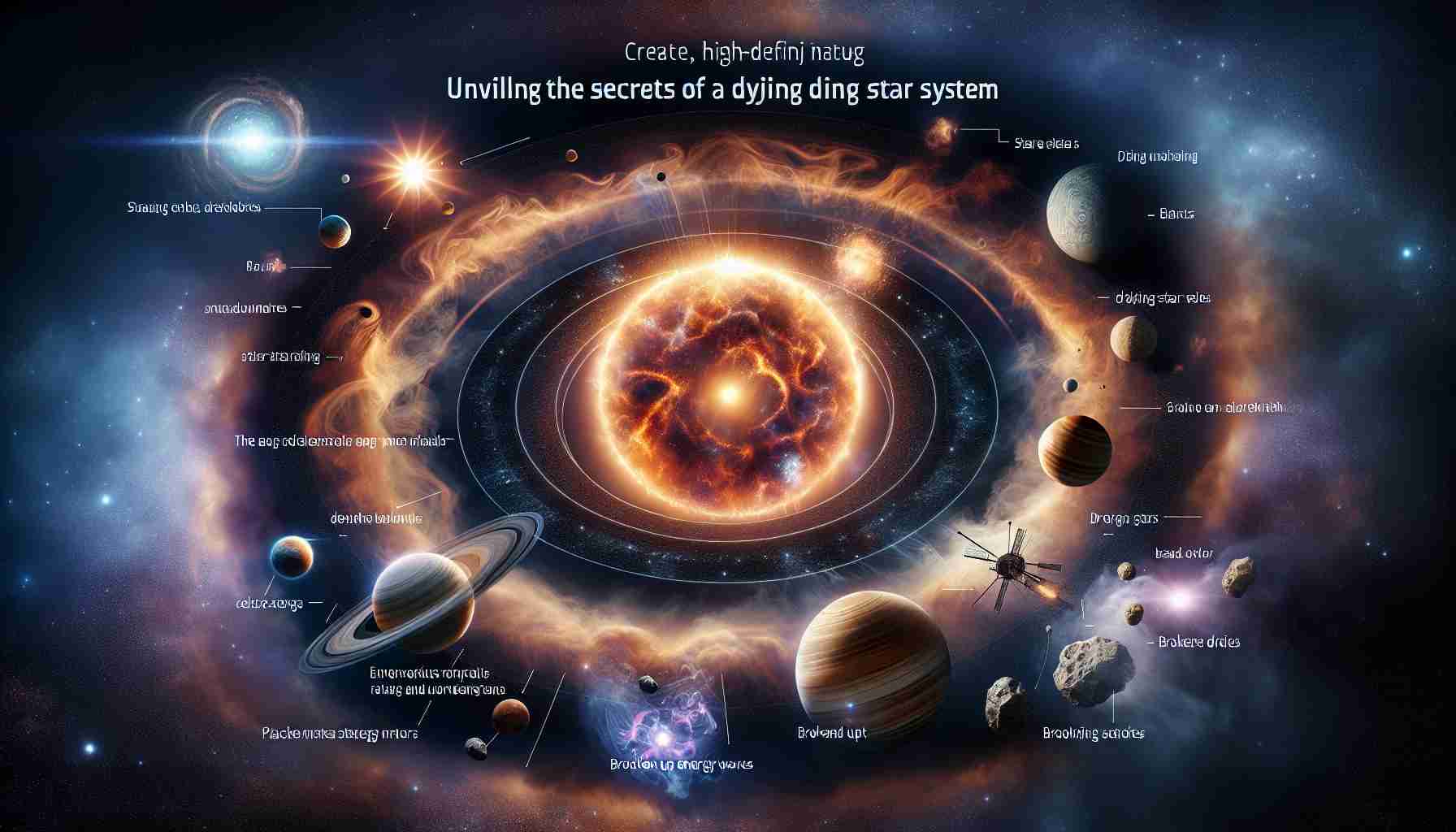The Amazing Findings of Wolf-Rayet 140
The James Webb Space Telescope (JWST) has once again dazzled us with a breathtaking portrayal of cosmic phenomena. This time, it has focused its gaze on the spectacular Wolf-Rayet 140, a dying star system located about 5,000 light-years away in the Cygnus constellation. The recent images reveal layers of carbon-rich dust, expanding outward from the star, creating mesmerizing structures akin to massive tree rings.
Researchers shared that these astounding observations provide insight into how massive stars release their outer layers, enriching the cosmos with essential building blocks for future celestial bodies. The intricate details of this star system’s evolution are crucial for understanding the lifecycle of massive stars and the creation of carbon in the universe.
A recent publication in The Astrophysical Journal Letters highlighted the binary nature of Wolf-Rayet 140, where two massive stars interact, producing unique dust rings. Each ring signifies a specific eight-year cycle of the stars’ intense winds colliding, compressing materials into these dynamic formations.
Notably, JWST’s mid-infrared capabilities allow scientists to capture the cooler, expanding dust shells, revealing their consistent outward movement across a remarkably short timeframe. Wolf-Rayet stars are among the most luminous and fleeting, shedding their mass in preparation for their cataclysmic ends—supernovae or the formation of black holes.
As astronomers continue to observe Wolf-Rayet 140, the quest to unlock the mysteries of stellar evolution and cosmic material cycling remains underway.
The Cosmic Impact of Wolf-Rayet 140 on Our Understanding of the Universe
The recent discoveries surrounding the Wolf-Rayet 140 star system by the James Webb Space Telescope (JWST) extend far beyond the realm of astronomy. They offer crucial insights into the processes that shape the universe, illustrating how the life cycle of massive stars impacts various interconnected aspects of existence, including the environment, humanity, the economy, and the future of our planet.
Wolf-Rayet 140 is not just a distant celestial body; it acts as a cosmic factory, generating carbon-rich dust that plays a pivotal role in the creation of new stars and planets. As these massive stars shed their outer layers, they enrich the interstellar medium with elements that are essential for life as we know it. This process is fundamental in the long-term evolution of galaxies and the development of planetary systems capable of supporting life.
The environmental implications of such stellar phenomena are profound. Elements like carbon are integral not only for the formation of new stars and planets but also for life itself. By understanding how stars like Wolf-Rayet 140 contribute to the chemical enrichment of the universe, we can appreciate the delicate balance within galactic ecosystems that facilitates the emergence of habitable conditions. This knowledge becomes crucial when considering the fate of our own planet Earth and its singular ecosystem.
From a human perspective, these cosmic processes can inspire a deeper appreciation for our place in the universe. As we face challenges such as climate change and environmental degradation, the understanding that we are part of a larger cosmic cycle can foster a greater commitment to protecting our planet. Recognizing the interconnectedness of all things—from the dust forged in dying stars to the life-sustaining elements on Earth—may provoke essential conversations about humanity’s stewardship of its own environment.
Additionally, the implications for the economy are noteworthy. The exploration of space, including studies such as those on Wolf-Rayet stars, produces technological advancements and spurs innovation. The JWST, for example, contributes to numerous sectors beyond astronomy, including materials science, communications, and data analysis. Investment in space research can drive economic growth, create jobs, and encourage a culture of exploration and discovery, reminding us that the pursuit of knowledge can have tangible benefits for society.
Looking towards the future, the continued study of stellar systems like Wolf-Rayet 140 is crucial for humanity’s survival and continued evolution. As we advance our understanding of stellar lifecycles, we can better appreciate the processes that led to the formation of our own solar system. This knowledge can guide us in our exploration of exoplanets and the search for extraterrestrial life, one of humanity’s most compelling quests.
Furthermore, as we stand at the threshold of potential space colonization and resource utilization beyond Earth, understanding cosmic material cycling becomes ever more important. The elements forged in stars may one day become resources for human endeavors in space, paving the way for a sustainable future that transcends our planet.
In conclusion, the exploration of Wolf-Rayet 140 serves as a powerful reminder of our connection to the cosmos. It reinforces the notion that understanding the universe’s vast complexities also informs our responsibilities here on Earth. The challenges we face today require a holistic perspective, one that embraces the wisdom gained from the stars while fostering a sustainable path for humanity’s future.
Unveiling the Mysteries of Wolf-Rayet 140: Insights from the James Webb Space Telescope
Introduction to Wolf-Rayet 140
The Wolf-Rayet 140 stellar system, located approximately 5,000 light-years away in the Cygnus constellation, presents a fascinating case for astronomers and astrophysicists. Recent observations made by the James Webb Space Telescope (JWST) have offered unparalleled insights into the life cycle of massive stars, particularly focusing on the complex interactions within this binary star system.
Key Features of Wolf-Rayet 140
Wolf-Rayet stars like WR 140 are characterized by their high luminosity and rapid shedding of mass. Their unique properties make them significant contributors to the chemical enrichment of the universe. Here are some notable features:
– Binary System: Wolf-Rayet 140 consists of two massive stars that periodically collide their stellar winds. This interaction leads to the formation of intricate dust shells visible in JWST’s observations.
– Dust Production: The star system’s rings of carbon-rich dust offer a glimpse into the material that contributes to the cosmic dust reservoir, essential for planet formation and other celestial bodies.
– Periodic Dust Rings: Each dust ring observed corresponds to an eight-year cycle of wind collisions, showcasing the dynamic nature of this stellar pair.
How the James Webb Space Telescope Enhances Our Understanding
JWST’s advanced mid-infrared capabilities provide a unique lens through which scientists can study the cooler, expanding dust shells around Wolf-Rayet 140. This technology allows astronomers to observe these phenomena in real-time, opening doors to revolutionary insights regarding:
– Stellar Evolution: By analyzing the dust structures, researchers can decipher the processes leading up to a massive star’s death, whether by supernova or black hole formation.
– Chemical Enrichment of the Universe: The materials expelled by Wolf-Rayet stars are critical for forming new stars and planetary systems, effectively acting as a nursery for future celestial objects.
Pros and Cons of Observing Wolf-Rayet 140
Pros:
– Expands knowledge of massive star evolution and lifecycle.
– Contributes to understanding cosmic material cycling.
– Utilizes cutting-edge technology for clearer observations.
Cons:
– Observations require significant resources and time.
– Findings may lead to more questions than answers, necessitating further research.
Use Cases and Future Implications
Continued study of Wolf-Rayet 140 has vast implications, including:
– Astrophysical Research: Insights into stellar life cycles can influence models of galaxy formation and evolution.
– Material Science: Understanding cosmic dust may lead to advancements in material science on Earth.
Limitations and Considerations
Despite the exciting findings surrounding Wolf-Rayet 140, there are limitations to consider:
– Observational Constraints: High-energy phenomena in astronomical settings can often be challenging to capture comprehensively.
– Interpretation of Data: Models based on observations must be continually refined as new data becomes available.
The Future of Wolf-Rayet Research
As astronomers leverage JWST and future missions, the potential to uncover more secrets of Wolf-Rayet stars is promising. This could reshape our understanding of the universe’s history and the intricate relationships between stars.
Conclusion
The recent observations of Wolf-Rayet 140 by the James Webb Space Telescope have opened new avenues for research and understanding in astrophysics. As we delve deeper into the cosmos, the collaboration of advanced technology and innovative research will continue to reveal the wonders of stellar phenomena.
For more information on cosmic phenomena and telescope discoveries, visit NASA.
















